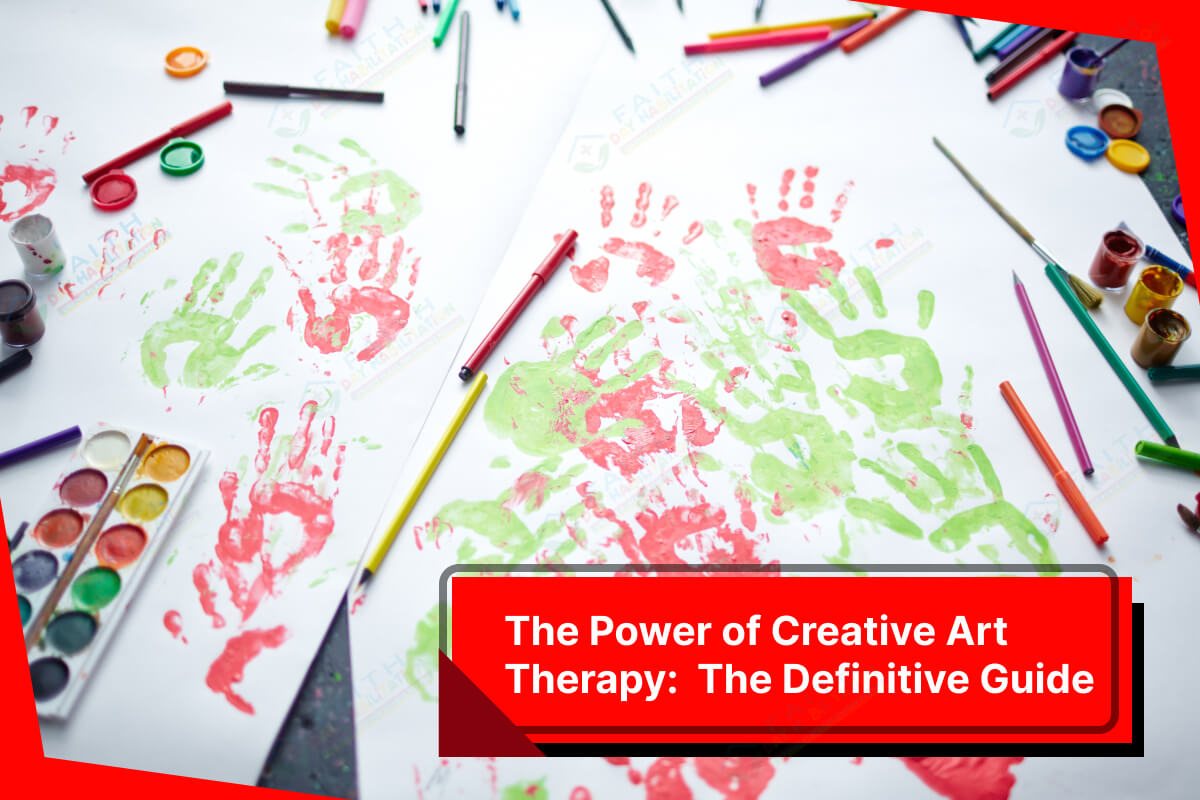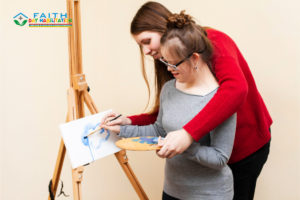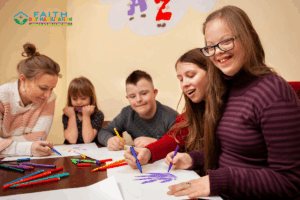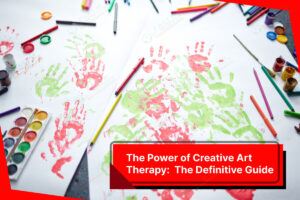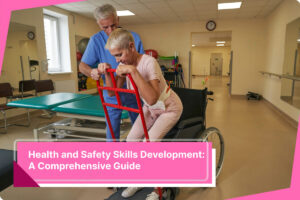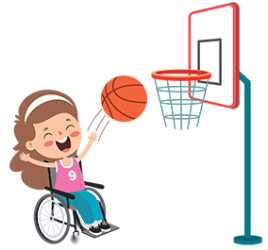Through expressive art, art therapy promotes mental health, emotional well-being, and personal development. Arts and crafts therapy allows people to examine their feelings, gain self-awareness, and learn new coping skills. This article discusses the many advantages of art therapy, especially arts and crafts, and how they may be adjusted for adults with impairments and autism.
The Essence of Art Therapy
Psychotherapy that uses art to heal is called art therapy. The idea is that artistic self-expression helps individuals settle problems, enhance interpersonal skills, control behavior, decrease stress, and gain understanding. Art therapy benefits all ages and may be done alone or in groups.
Art therapy originated in the mid-20th century when doctors and artists realized that creativity could heal. Adrian Hill and Margaret Naumburg pioneered art therapy as a formal profession, recognizing its ability to break down emotional boundaries and improve mental health.
Benefits of Art Therapy
- Expressing and Processing Emotions
A major advantage of art therapy is helping people express and process tough feelings. Explore and express your emotions through art to get emotional clarity and insight. - Stress Reduction
Crafting reduces stress. Crafting’s rhythm and repetition may inspire meditation, relaxing and lowering anxiety. Painting, crocheting, and sculpting relieve stress and relax. - Better Cognition
Adults’ cognitive performance may be improved by art therapy. Creative activities activate brain regions, boosting cognition. Crafting may increase executive functions via problem-solving, while clay modeling can improve fine motor skills and sensory processing through tactile interaction. - Social Integration
Group art therapy promotes community and belonging. Participants encourage one another, have creative experiences, and form important bonds. This is especially helpful for mentally or physically disabled people who feel alone.
Therapy with Art and Craft
- Different Artforms
Art therapy entails various activities, each with its own benefits. Common forms are:
- Expressive and illustrative, drawing and painting are media in a position to explain emotions and ideas.
- Sculpting and clay work call for touch and contact, which provides the body with a sense of grounding and proprioception.
- The combination of different materials raises issues of individual and collective identity as well as history.
- Customizing Adult Activities
Art and craft activities may be offered in a manner suitable for adults who might be interested. Some customized methods:
- Some of the typical facilities that engage in adult arts and crafts include community centers, rehabilitation centers, and mental clinics.
- The provision of structured activities to aid people who have enduring physical or neurological issues.
- Adult Art & Crafts
Arts & crafts programs near me for adults promote creativity and should be appropriate for the specific age bracket of the adults. Some popular activities are:
- Painting workshops: Exploration through creative practice and technical support sessions.
- Pottery classes: They must make useful or decorative pottery.
- Jewelry Making: Creating individual ornaments of different materials and techniques.
- Mixed Media Art: Drawing entirely new pieces into paintings, collages, and sculptures.
Adult Art & Craft Ideas
Creative arts and crafts activities for adults may help folks relax and express themselves. Innovative arts and crafts ideas for adults include:
- Intricate graphics in mindfulness coloring books help you relax and concentrate.
- Recycling common materials into art promotes creativity and environmental awareness.
- Painted vases, wall hangings, and candles are DIY home décor.
- Celebrating seasons and holidays via craft projects builds community and tradition.
Craft Ideas for Disabled Adults
Arts & crafts geared to disabled adults are very beneficial. These exercises improve motor skills, self-esteem, and achievement. Arts and crafts ideas for adults with disabilities include:
- Custom brushes and painting aids for physical restrictions are used in adaptive painting.
- Textured collages and fragrant clay modeling are sensory art projects.
- Social, collaborative undertakings with responsibilities tailored to individual talents
- Beading for fine motor skill development or large-scale weaving for restricted dexterity are examples of customized crafts.
Art & Crafts for Autism
Art therapy gives autistic people a nonverbal medium for expression and communication. Examples of beneficial arts and crafts activities for autism includes:
- Drawing, painting, and other visual arts help autistic people express themselves.
- Sand painting and fabric collages are examples of sensory-based art.
- Clear directions and predictable activities lessen anxiety.
- Collaboration via group art projects promotes communication and collaboration.
Examples and Uses
Community centers and non-profits provide therapeutic arts and crafts classes. These programs enable creative expression, socialization, and well-being. A senior community arts program may provide painting workshops that improve cognition and purpose.
Rehabilitation facilities employ creative arts and crafts ideas for adults to aid physical recovery. Patients suffering from strokes or severe brain injuries may improve fine motor skills and hand-eye coordination. In a stroke patient case study, frequent pottery sessions restored dexterity and confidence.
Communication and social skills have improved in autism art therapy programs. One program offered weekly sensory exploration and creative expression art classes for autistic youngsters. Participants reported improved social interaction and lower anxiety.
Arts and Crafts Program Implementation
- Establishing Objectives
Establishing program goals and objectives is essential when conducting an arts and crafts program. They may include:
- Promoting emotional well-being: A safe area for emotional expression and stress reduction.
- Engaging participants: Engaging participants in cognitive and fine motor skills exercises improves such abilities.
- Promoting social interaction: Helping individuals create social networks.
- Promoting creativity and self-expression: Growing people’s creativity and identity.
- Activity Design
Participant requirements and interests are key to designing successful arts and crafts events. Considerations include:
- Accessible: Making activities accessible and suitable for participants’ skill levels.
- Material and tool variety: Offering materials and tools for diverse talents and preferences.
- Structure and flexibility: Combine scheduled activity with spontaneous inventiveness.
- Training and Support for Facilitators
Facilitators are vital to arts and crafts program success. They may lead participants and create a good, therapeutic atmosphere with adequate training and support. Training should cover:
- Facilitators learn art therapy ideas and advantages.
- Facilitators learn how to plan and adjust activities for diverse groups.
- Building communication and emotional support abilities.
- Assessment of Program Success
Regular program assessment helps determine its efficacy and opportunities for improvement. Evaluation techniques may include:
- Participant feedback: Asking participants about their experiences and activity effects.
- Behavioral observations: Tracking participant mood, behavior, and social interactions.
- Outcome metrics: standardized outcome metrics for mental health, cognitive function, and physical ability.
Conclusion
Art therapy uses arts and crafts to improve well-being in a creative and effective way. Creative arts and crafts help reduce stress, improve cognition, and promote social ties.
These exercises are tailored to diverse adult groups, including those with impairments and autism, so that everyone can benefit from creativity. Art therapy can potentially improve lives and promote holistic health via the simple but profound act of producing art.




